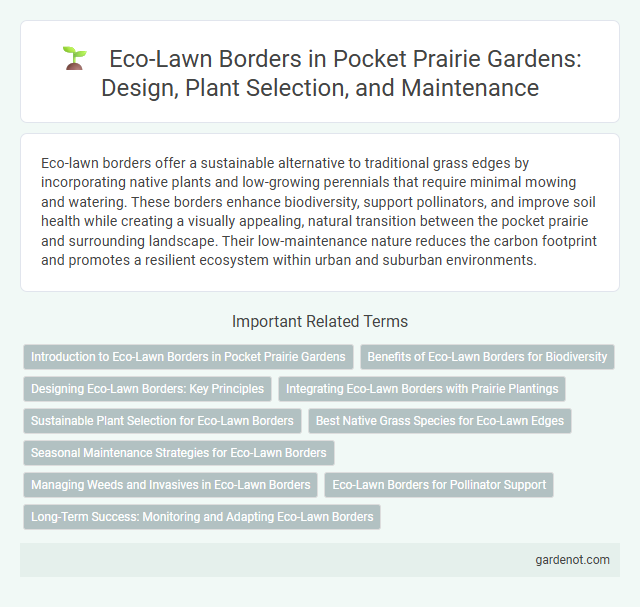Eco-lawn borders offer a sustainable alternative to traditional grass edges by incorporating native plants and low-growing perennials that require minimal mowing and watering. These borders enhance biodiversity, support pollinators, and improve soil health while creating a visually appealing, natural transition between the pocket prairie and surrounding landscape. Their low-maintenance nature reduces the carbon footprint and promotes a resilient ecosystem within urban and suburban environments.
Introduction to Eco-Lawn Borders in Pocket Prairie Gardens
Eco-lawn borders in pocket prairie gardens provide a sustainable alternative to traditional grass edges by incorporating native grasses and wildflowers that support local biodiversity. These borders enhance habitat connectivity for pollinators and beneficial insects while reducing water use and maintenance requirements. Integrating eco-lawn borders into pocket prairies helps create resilient, ecologically rich landscapes that promote soil health and wildlife diversity.
Benefits of Eco-Lawn Borders for Biodiversity
Eco-lawn borders enhance biodiversity by providing habitat for pollinators such as bees, butterflies, and native insects. Their diverse plant species support a wider range of wildlife compared to conventional grass lawns, promoting ecosystem resilience. These borders also improve soil health and reduce the need for chemical inputs, contributing to sustainable garden management.
Designing Eco-Lawn Borders: Key Principles
Designing eco-lawn borders requires selecting native, drought-tolerant plants that enhance biodiversity and support pollinators while minimizing maintenance. Incorporating varied textures and heights creates natural habitat corridors, promoting ecological balance. Soil health management and avoiding synthetic chemicals are essential to sustain a resilient, environmentally friendly lawn border.
Integrating Eco-Lawn Borders with Prairie Plantings
Integrating eco-lawn borders with prairie plantings enhances biodiversity by creating seamless transitions between traditional grassy areas and native wildflowers. Eco-lawn borders, composed of low-maintenance, drought-tolerant grasses such as fine fescues, complement prairie species like little bluestem and purple coneflower, promoting soil health and habitat connectivity. This combination supports pollinator populations and reduces the need for irrigation and chemical inputs, making it an environmentally sustainable landscaping choice.
Sustainable Plant Selection for Eco-Lawn Borders
Eco-lawn borders feature sustainable plant selection emphasizing native grasses and drought-tolerant species that enhance biodiversity and reduce water consumption. Incorporating deep-rooted plants like buffalo grass and blue grama improves soil health and supports local pollinators. These choices minimize maintenance needs while promoting a resilient, eco-friendly landscape.
Best Native Grass Species for Eco-Lawn Edges
Fine fescues (Festuca spp.) and buffalo grass (Bouteloua dactyloides) rank among the best native grass species for eco-lawn borders due to their low maintenance, drought tolerance, and resilience to foot traffic. These grasses promote biodiversity by providing habitat for pollinators and beneficial insects while requiring minimal fertilizers and irrigation. Integrating native grasses like blue grama (Bouteloua gracilis) enhances soil health and supports sustainable pocket prairie ecosystems along lawn edges.
Seasonal Maintenance Strategies for Eco-Lawn Borders
Eco-lawn borders require targeted seasonal maintenance strategies to promote biodiversity and soil health. In spring, aerate the soil and overseed native grasses to ensure dense coverage, while in summer, manage irrigation carefully to prevent drought stress. Fall involves reducing mowing frequency and applying organic mulch to enhance nutrient cycling and overwinter resilience.
Managing Weeds and Invasives in Eco-Lawn Borders
Eco-lawn borders utilize low-growing native plants that create dense ground cover, effectively suppressing weed growth through natural competition. Incorporating drought-tolerant species like creeping thyme and chamomile reduces the need for chemical herbicides, promoting a sustainable, biodiverse edge. Regular maintenance through targeted weeding and mulching supports the resilience of native plants, limiting invasive species encroachment.
Eco-Lawn Borders for Pollinator Support
Eco-lawn borders provide vital habitat and nectar sources for pollinators, enhancing biodiversity in pocket prairies. These low-maintenance, native grass and wildflower mixes support bees, butterflies, and other beneficial insects by offering continuous bloom periods. Incorporating eco-lawn borders promotes ecological balance, soil health, and pollinator population resilience in urban and suburban landscapes.
Long-Term Success: Monitoring and Adapting Eco-Lawn Borders
Eco-lawn borders thrive through consistent monitoring of soil health, plant diversity, and moisture levels to ensure long-term success in pocket prairies. Adaptive management practices, such as targeted reseeding and selective weeding, help maintain ecological balance and promote resilience against pests and environmental stressors. Utilizing native grasses and wildflowers tailored to local conditions enhances sustainability and supports pollinator habitats over time.
Eco-lawn border Infographic

 gardenot.com
gardenot.com